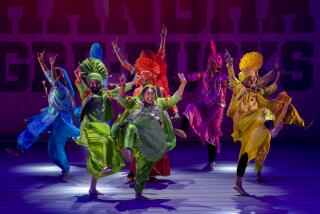Spinning Tales With Music and Motion
- Share via
Although in its present form the kathak dance idiom of north India dates back 150 years, with roots much older, the rhythmic interplay of dancer and drummer gives it an immediacy that can speak to any audience anywhere. With a percussionist seated nearby, the dancer performs barefoot, wearing loose, flowing garments and thick clusters of ankle bells, darting and whirling through complex cycles of drumbeats before coming to rest in one last triumphant flourish of matched sound and motion.
On Sunday at Pasadena City College, the lead dancer and guest drummer were two of India’s great stars: kathak master Birju Maharaj, whom Ravi Shankar introduced as “one of the miracles that we have in the world of dance,” and tabla prodigy Zakir Hussain, familiar to international audiences from many cross-cultural collaborations. Their rapport in two extended kathak improvisations represented the highlight of a program further distinguished by the dancing of the radiant, accomplished Saswati Sen, along with other dancers and musicians in Maharaj’s nine-member company.
Never in the spotlight, always deferential, Hussain supplied forceful, intricate, high-velocity accompaniments, putting his own spin on the rhythmic patterns that Maharaj would invent in chanted passages resembling jazz scat singing and making those patterns a platform for exciting, spontaneous display dancing.
Unfortunately, the ruinous sight lines of Sexson Auditorium made the footwork unseeable and only those very close to the stage could appreciate one of Maharaj’s greatest assets: his infinitely expressive eyes. Kathak was originally a storytelling idiom, and Maharaj renewed that tradition in his wondrous performances of narrative works requiring detailed changes of stance, gesture and eye motion to embody different characters, including an elephant and a peacock.
Sen also served as an object lesson in dance-acting, at one point portraying both the god Krishna and his beloved Radha in the act of successfully impersonating Krisha. The big difference between the real and the imitation: the eyes.
Presented by the Pasadena-based Music Circle, the Maharaj/Hussain performance formed part of a daylong event that also featured a program by sarod virtuoso Amjad Ali Khad and a ceremony honoring Ravi Shankar.
More to Read
The biggest entertainment stories
Get our big stories about Hollywood, film, television, music, arts, culture and more right in your inbox as soon as they publish.
You may occasionally receive promotional content from the Los Angeles Times.










